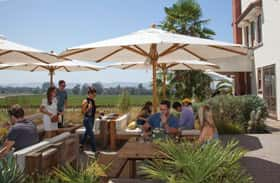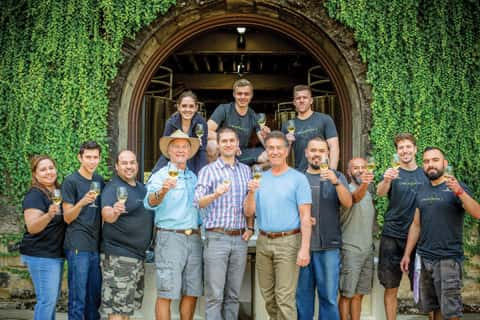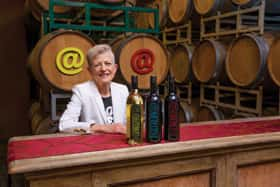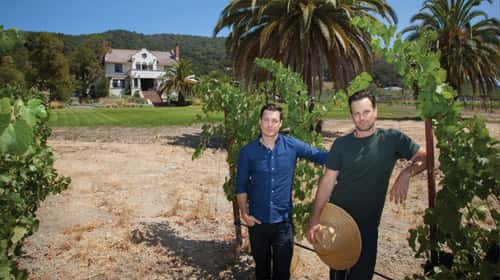Scribe Winery, located at the end of a palm tree-paved Dresel Road in Sonoma, has found a way to attract the seemingly ever-elusive Millennial market. The winery, both rural and trendy, is often frequented by young wine enthusiasts, eager for Rosé all day. The relaxed vibe at Scribe removes the intimidation factor of wine, making it a popular stop for the 20- and 30-something crowd.
Andrew Mariani, co-owner of Scribe, believes it’s not about trying to lure in the younger generation, but offering quality wine in a contemporary atmosphere. “It should feel timeless, and honest,” he says, swirling a glass of cold Rosé. He stands on a hillside of oak trees and vines that divides the two tasting areas, and is surrounded by a dust cloud of dirt and volcanic ash from our hike up the vineyard, proudly viewing the bustling hilltop tasting area. Mariani isn’t concerned with inspecting the patterns of the Millennial generation, or strategizing how to get them to visit his vineyard. Instead, he creates a setting he believes in, and it works. As a member of the generation, who’s been stepping into the wine world for the past decade, I’m in it for the love of good wine, but can appreciate the benefits and perks a winery might offer to capture my generation. Here’s a look at the Millennial generation and how several wineries are using clever marketing approaches and targeting young consumers.
The Millennial generation
Born in the early 1980s to 2000s, Millennials are one of the most difficult generations to identify from a branding standpoint, and wineries are wondering how to capture the market. According to the Wine Market Council, Millennials consumed 42 percent of all wine in the United States in 2015—more than any other age group. In addition, they drink an average of three glasses per sitting.
One Napa winemaker recognizes the challenges of the Millennial wave of wine drinkers. Matthew Crafton at Chateau Montelena in Calistoga is drawn to understanding the generational differences. “You can identify the Boomers and Gen Xers, and then you have this giant unknown,” says the 35-year-old head winemaker. “That’s what makes this demographic so interesting and intriguing.”
The Millennial market is attractive and exciting, but is met with branding challenges, says Trini Amador, managing partner at BHC Consulting and co-owner of Gracianna Winery in Healdsburg. “To understand their connection to wine is to understand an indecisive and movable target,” he says. “We acknowledge them as urbane, technophiles and anywhere from sensitive to allergic to classic marketing because they were kids not exposed to but wary to the sophisticated marketing programs and techniques that were honed before social media.”
Low-to mid-price wines are the right entry point for Millenialls, says Amador. The “Peter Pan Generation” as American sociologist and author of The Crowded Nest Syndrome Kathleen Shaputis refers to them, might hold off on growing up and hold onto their value on differentiation and price.
Some marketers and wineries rely on adventurous approaches or packaging to attract the young market. Products with various sizes and packaging, and experiences such as delivery and BYOB services can separate a brand from the rest, adding an attractive element. There are wine in cans, low carb wines, blue champagne and Rosé forties (like the forty-ounce malt liquor bottles). They can seem enticing for a moment—but in the end, what sticks?
“I don’t think gimmicks work. I think it’s a flash in the pan,” says Crafton. With information flowing so quickly, what’s hot for 15 minutes, is dead in 20. Amador recognizes the trend of what might seem like gimmicky wine products. “We see more Rosé, flavored-infused products that are in bottle, box, tube, can, glass, plastic—they are open to anything that is differentiated,” he says. However, the opportunity for wine innovators comes with the Millennials’ absence of wine traditions since they have no preconceived ideas about what they are or should be, says Amador.
 In search of a scene
In search of a scene
Whether by chance or design, Scribe has created an environment that appeals to a young generation in search of a scene. Owners Andrew and Adam Mariani started the winery in their 20s. Andrew was 24 and has run the winery, which sits on 256 acres of land, for 10 years now. The brothers planted the grapes since nothing had been planted on property post-Prohibition.
What draws young hipsters and city slickers to the rural outskirts of Sonoma? It may be the hilltop tastings, where guests are surrounded by oak trees that shade picnic tables while their dogs rest at their feet. It may be the communal seating outside the hacienda farmhouse where local chefs feature several courses from ingredients grown on property. Or, maybe it’s the soft lounge music, which adds to the ambiance, where for a moment, it can feel as if you’re at a posh restaurant with the whose-who, rather than a tasting room.
Lauren, a host at Scribe for nearly two years, says her parents are wine club members, but she notices a mix of people of varying ages. “I’m 28 and live in San Francisco,” she says. “My friends are club members. They’re on the smaller end of the purchasing spectrum.”
The wines at Scribe range in prices (less than $40 and up to $178 for selected magnum bottles). Their ever-popular Rosé sells for $38 and is kept on ice, ready to pour as visitors arrive. “People are obsessed with Rosé right now. Every weekend someone will buy a case,” says Lauren. “You feel as if you’re coming to someone’s backyard and drinking wine.”
“The property is both old and new. It has depth to it,” says Mariani of the property that was once a turkey farm for 50 years. Similar to his wines, the depth and the future vines planted make for a versatile place to visit and enjoy—something for not just the Millennials but for everyone.
 Balancing generations
Balancing generations
Recognizing the different needs of two generations is a balancing act that Crafton finds both compelling and fascinating. “We’re not unique in that we like our customers to fit in a box. We like to identify who those people are and tailor how we communicate with them based on what they need,” says Crafton.
A concern wineries are facing is the lack of brand loyalty with Millennial wine consumers. “Millennials are not necessarily as brand loyal as Boomers are,” adds Crafton. “They’re adventurous with their palates and interested in new varieties and regions.” On the production end, Crafton’s approach includes taking a perceived “weakness”— an established brand—and turning it into a strength. There is a benefit in offering the convenience of getting different types of wine that a consumer knows they’re going to enjoy, and providing the ease of ordering over the phone or online and receiving it quickly and inexpensively. “Maybe that’s the appeal right there,” says Crafton. “I want you to buy our wine, bring it home, love it and feel it has good value.”
What some wine marketing and branding experts may see as deterring, Crafton sees as an unusual advantage in marketing to Millennials. Unlike Boomers and Gen Xers, Millennials were exposed to non-traditional education in the form of social media and search engines at a young age. The difference between wine banter with the two generations is like comparing apples to oranges. “When I go to events or travel for the winery and meet people who’ve been our customers for some time, we discuss old bottles, what’s stored in their cellar, not necessarily what we’re doing on the cutting edge,” says Crafton.
 Boomers consider wine ratings and specific vintages when picking wines. On the other hand, the new generation of wine consumers are less impressed with vintage, and more intrigued with unique qualities and adventurous flavor profiles. When he speaks with Millennials, his conversations are usually centered around inquisitive details about Chateau Montelena’s unique oaks and sourced vineyards, a result of the generations extensive research. Having information right at your fingertips, he says, brings forth sophistication and accessibility. “That’s a tightrope we try to walk.”
Boomers consider wine ratings and specific vintages when picking wines. On the other hand, the new generation of wine consumers are less impressed with vintage, and more intrigued with unique qualities and adventurous flavor profiles. When he speaks with Millennials, his conversations are usually centered around inquisitive details about Chateau Montelena’s unique oaks and sourced vineyards, a result of the generations extensive research. Having information right at your fingertips, he says, brings forth sophistication and accessibility. “That’s a tightrope we try to walk.”
Is it possible to grasp the Millennial market? In the end, it’s all about quality and value, says Crafton. Sitting in his leather office chair across the table, sipping ice water and looking out the window at the shuffling of multi-generations in and out of the winery, there is an ease and confidence in him. “Put out a super high-quality product, put out something that’s real, not adulterated and engineered. I think that has universal appeal and explains why we have so many loyal customers.”
@Wines are where it’s at
“When texting doesn’t fit the bill. When real face time is the key, this wine is where it’s @.” This catchy tag line stands behind Deerfield Ranch Winery’s @Wines, which owners PJ and Robert Rex launched specifically for the Millennial market.
 “We wanted to introduce Millennials to clean wine—wines that didn’t give them a headache and wines they could afford,” says PJ. Sitting at her new table in one of the many hidden corners of Deerfield’s extensive wine cave, PJ is wearing her custom denim jacket that reads “Got Clean Wine” on the back and pours a taste of the @Chardonnay. Deerfield produces clean wine—wines low in sulfites and low in histamines—avoiding the wine-hangover that usually arrives the next day. PJ’s husband and winemaker, Robert, was inspired to create clean wines after PJ developed a severe allergy to sulfite and hearing her college interns say they didn’t drink wine because it gave them a headache the next day in class. “I wanted to educate them,” she says.
“We wanted to introduce Millennials to clean wine—wines that didn’t give them a headache and wines they could afford,” says PJ. Sitting at her new table in one of the many hidden corners of Deerfield’s extensive wine cave, PJ is wearing her custom denim jacket that reads “Got Clean Wine” on the back and pours a taste of the @Chardonnay. Deerfield produces clean wine—wines low in sulfites and low in histamines—avoiding the wine-hangover that usually arrives the next day. PJ’s husband and winemaker, Robert, was inspired to create clean wines after PJ developed a severe allergy to sulfite and hearing her college interns say they didn’t drink wine because it gave them a headache the next day in class. “I wanted to educate them,” she says.
PJ’s passion for educating the new generation of wine drinkers continues through Deerfield’s @Wines and her intern program. Priced at $24 per bottle—$19 for wine club members—Deerfield Ranch offers three @Wines: Chardonnay, Merlot and Cabernet Sauvignon. In addition, recipe cards and shopping lists are provided, adding an educational and approachable wine and food experience. “The idea is to make wine approachable: three wines, three recipes and three shopping lists,” she says. “And now they’re in the game.” All recipes were developed by her friend, Chef Jean Pierre, author of Cooking 101.
“Millennials bring a lot to the table,” she says about the joy and excitement she feels toward embracing the generation at the tasting room. “They are concerned about the quality of the environment and the food they eat.” Millennials are drawn to the clean wine concept at Deerfield Ranch and that it is a certified organic winery. “I love working with Millennials because if you keep them engaged and learning, they become inspired.”
Taking the long view
As Millennials continue to dominate the market, quality wines and reasonable prices will remain a promising attraction to the adventurous generation of drinkers. Capturing the attention of Millennials through price and differentiation can result in sales, but gaining brand loyalty and connecting in a human way can be a task. “We simply and emotionally need to break through,” says Amador. “They are the Google, Facebook, mobile phone app generation,” he says. “They do not need to emotionally connect because with a torrent of information at their fingertips, they don’t need to remember anything since their ‘internal drive’ is only a Google search away.”
The mystery of the Millennial market may never be solved. But that doesn’t mean wineries will stop trying any time soon. “The wineries that are going to be successful are those who take the long view,” adds Crafton. “At the end of the day, we try to be down to earth, honest in our communication and we innovate in the vineyard and cellar.”
As for me and my friends, we don’t always fit the Millennial profile in the tasting room. I’ll continue to gravitate toward fruit forward reds with aromatic complexity at tiny hidden tasting rooms, but, as a product of my generation, my audacious spirit will never turn down the opportunity to try new things. Blend it, Jell-O it—put it in a growler for all I care—this Millennial is always game to try something new.




